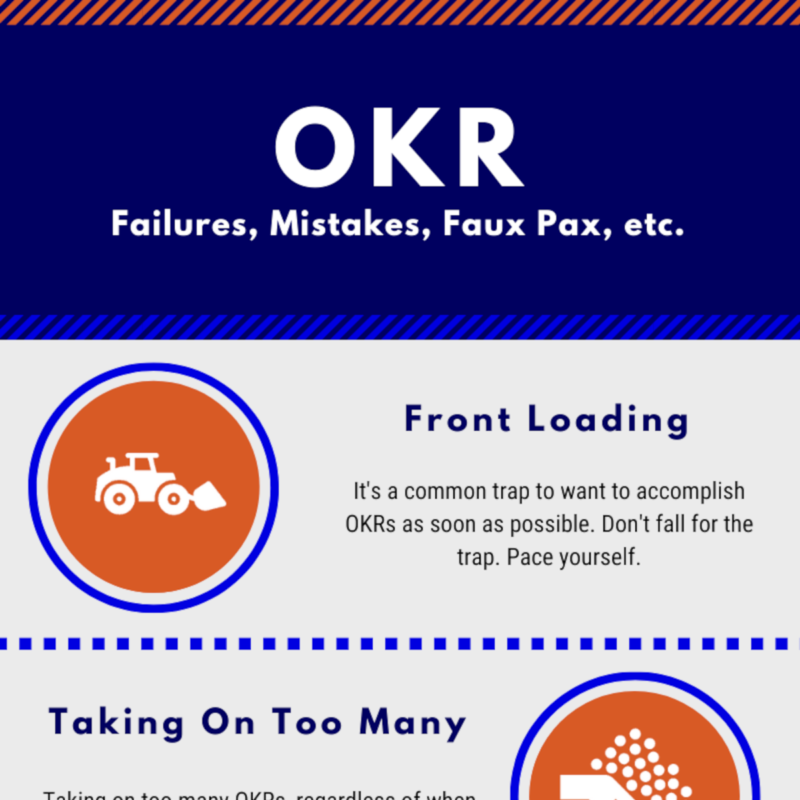OKRs are relatively straight-forward and easy to implement. And my article series on OKRs is here to help. Just the same, there are a few areas where leadership teams tend to go a little sideways. Let’s step through the top few and make sure these don’t catch you by surprise.
1. Front-Loading the Majority of OKRs

This is probably my favorite and the one that shows up most predictably. This shows up most frequently with leadership teams new to strategic planning generally, and OKRs specifically.
I know this makes me sound like a bit of a dork, but getting to the end of strategic planning really is exciting. It’s energizing. You’re excited about the future and the awesome changes you’re going to make happen in the business. Moreover, you’re really excited to start making all those changes happen right now. Without fail, I’ll see teams schedule all their OKRs with deadlines for the first two quarters of the year.
Then they step back, scratch their heads, and realize that just isn’t going to work.
Pac yourself. And don’t worry about the fact that you’re pushing back really good work. You’re going to be very busy keeping up with your regular work, as well as making the OKRs that you do choose happen. It’s okay – we’ll get to all of it.
2. Taking on Too Many OKRs

This is closely related to #1 above. In addition to scheduling all the OKRs upfront, I especially see newer teams try to take on way too many OKRs. It’s just not practical. As transformative work, OKRs tend to soak up as much time as you’re willing to give them. That’s why it’s important to only budget a small number of OKRs at any given time to make sure you don’t overwhelm yourself and your team. This is definitely a “less is more situation.” So focus on the critical few that will provide the greatest impact.
3. Focusing Too Much on OKRs

And this item stems directly from #2 above. When you focus too much on OKRs, what do you suppose tends to suffer? You got it – ironically, the rest of your business suffers. You can’t let that happen.
When you’re focused on executing OKR plans, you cannot let it impact the rest of your business negatively. OKR plans must lift your entire business up without dragging any piece down. So before taking on that next big piece of transformative work, be sure to assess whether you have the energy, resources, and ability to focus on your regularly scheduled work as well as the new agenda.
![]()
Download Your FREE OKR Workbook
Get a pre-made Excel template featuring examples, explanations, and built-in calculations.
4. Failing to Create a Review Ritual

Some teams prefer not to set aside dedicated time each month to formally review and record progress and issues against their OKRs plans. They prefer instead to review their OKRs as they go along from week to week.
That’s a real mistake. Do both.
Absolutely review your progress as part of your regular work. That’s why OKRs are so advantageous – blending into your daily work. But also absolutely set aside time for a ritual focused on formally reviewing OKR progress, celebrating success, and debugging lack of progress. For more information as to why, see my article on the importance and value of the formal monthly review ritual.
5. Confusing OKRs and KPIs

Objectives and Key Results (OKRs) and Key Performance Indicators (KPIs) are closely related. And the way I use them, both come into play in strategic planning and execution. That said, they are different tools with unique characteristics. It helps to keep them clear in your mind. With that in mind, I’ve outlined their similarities and differences here, and I have a separate article series on KPIs here.
Take a look at those resources and check out how each can help your business.
Bringing it All Together
Implementing OKRs is relatively easy. Just make sure to side-step these common issues as you go.
![]()
Download Your FREE OKR Workbook
Get a pre-made Excel template featuring examples, explanations, and built-in calculations.


